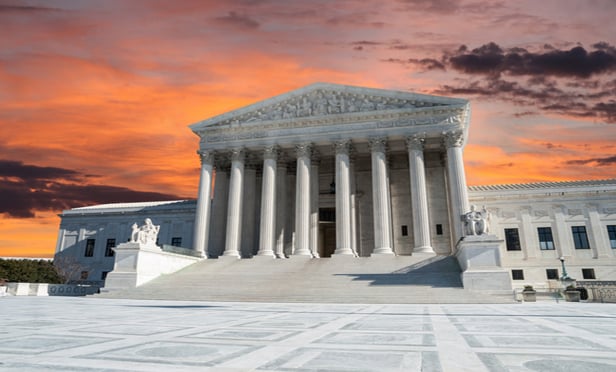Columns & Departments
Co-ops and Condominiums
Condominium Purchaser Was On Inquiry Notice of Unrecorded Easement Condominium Board May Not Depart from Declaration's Funding Provisions Failure to Make Repairs Does Not Excuse Failure to Pay Common Charges
Features

Effectively Managing Partner Autonomy
The past decade has brought a significant rise in internal conflict within partnerships. Partners are wielding their autonomy to speak out (often forcefully) in favor of or opposition to broader firm decisions. This dynamic is leaving many law firms at a disadvantage.
Features

Is FEPA As Impactful As It Was Promised to Be?
FEPA, which amends the federal domestic bribery statute has been touted by some as "the most sweeping and consequential foreign bribery law in nearly half a century." But will it end up being an influential force combatting corruption or a paper tiger?
Features

Federal Circuit Overrules 'Improperly Rigid' Obviousness Test
In an eagerly anticipated decision involving the proper standard for assessing when a claimed design is obvious, the Federal Circuit overruled the Rosen-Durling test that courts and the USPTO have been applying for nearly 30 years, calling the test "improperly rigid" and inconsistent with Supreme Court precedent.
Features

Do FL and CA Talent Agency Law Cover Social Media Influencers and Esports Talent?
If the definition for "artist" under Florida's Talent Agencies Act applies to influencers and esports players, then likely a lot of unlicensed representatives are in violation of the state's statute — and the penalties are pretty serious.
Features

SCOTUS: Prospective Relief Is Only Remedy Necessary to Resolve Unconstitutional U.S. Trustee Fee Scheme
In a recent decision, the U.S. Supreme Court held that the government was not required to refund millions of dollars paid by a Chapter 11 debtor pursuant to an unconstitutional fee scheme between the judicial districts.
Features

Fifth Circuit Agrees With 'Cleary': Corporate Debtors Are Subject to Section 523(a) In Subchapter V Case
Armed with two circuit-level decisions, creditors who lose at the bankruptcy court level may feel encouraged to appeal. As of now, no court in the Second Circuit has addressed the issue and it remains to be seen how other courts will react.
Columns & Departments
Landlord & Tenant Law
Notice Sufficient In Action to Eject Occupant Lease's Taking Clause Excuses Tenant from Payment of Rent<br Village's ETPA Resolution Upheld Landlord's Delay In Providing Itemized Statement Precludes Landlord from Retaining Any Portion of Security Deposit Assignee Liable for Breach of Lease Constructive Eviction and Warranty of Habitability Defenses Rejected
Features

Idaho District Court Imposes First-Ever Bond Order Under the State's Bad Faith Assertions of Patent Infringement Act
The Act is intended to guard against patent trolling and creates a private cause of action for those targeted by bad faith infringement assertions and contemplates two types of relief: remedies and a bond requirement.
Features

The Future of the SEC's Climate Change Disclosure Rules If Regulatory Polices Are Reversed
Depending on the results of the election in November, there may be major reversals in securities regulation and SEC policies. In particular, the SEC's much discussed and much litigated climate disclosure rules may be abandoned by a Trump SEC.
Need Help?
- Prefer an IP authenticated environment? Request a transition or call 800-756-8993.
- Need other assistance? email Customer Service or call 1-877-256-2472.
MOST POPULAR STORIES
- The DOJ's Corporate Enforcement Policy: One Year LaterThe DOJ's Criminal Division issued three declinations since the issuance of the revised CEP a year ago. Review of these cases gives insight into DOJ's implementation of the new policy in practice.Read More ›
- The DOJ's New Parameters for Evaluating Corporate Compliance ProgramsThe parameters set forth in the DOJ's memorandum have implications not only for the government's evaluation of compliance programs in the context of criminal charging decisions, but also for how defense counsel structure their conference-room advocacy seeking declinations or lesser sanctions in both criminal and civil investigations.Read More ›
- Use of Deferred Prosecution Agreements In White Collar InvestigationsThis article discusses the practical and policy reasons for the use of DPAs and NPAs in white-collar criminal investigations, and considers the NDAA's new reporting provision and its relationship with other efforts to enhance transparency in DOJ decision-making.Read More ›
- A Playbook for Disrupting Traditional CRMHere's the playbook for disruption: Take attorneys out of the equation. Stop building CRM that succeeds or fails on their shoulders. We need to shift the focus and, instead, build the technology from the ground up for the professionals who actually use it: marketing and business development.Read More ›
- Bankruptcy Sales: Finding a Diamond In the RoughThere is no efficient market for the sale of bankruptcy assets. Inefficient markets yield a transactional drag, potentially dampening the ability of debtors and trustees to maximize value for creditors. This article identifies ways in which investors may more easily discover bankruptcy asset sales.Read More ›
